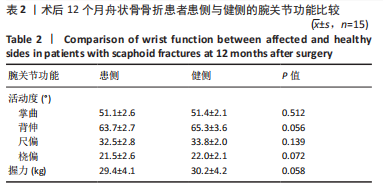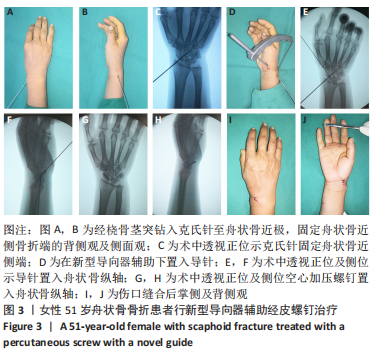[1] ARSALAN-WERNER A, SAUERBIER M, MEHLING IM. Current concepts for the treatment of acute scaphoid fractures. Eur J Trauma Emerg Surg. 2016;42(1):3-10.
[2] HOVE LM. Epidemiology of scaphoid fractures in Bergen, Norway. Scand J Plast Reconstr Surg Hand Surg. 1999;33(4):423-426.
[3] MACK GR, WILCKENS JH, MCPHERSON SA. Subacute scaphoid fractures. A closer look at closed treatment. Am J Sports Med. 1998;26(1):56-58.
[4] DÜPPE H, JOHNELL O, LUNDBORG G, et al. Long-term results of fracture of the scaphoid. A follow-up study of more than thirty years. J Bone Joint Surg Am. 1994;76(2):249-252.
[5] ALNAEEM H, ALDEKHAYEL S, KANEVSKY J, et al. A Systematic Review and Meta-Analysis Examining the Differences Between Nonsurgical Management and Percutaneous Fixation of Minimally and Nondisplaced Scaphoid Fractures. J Hand Surg Am. 2016;41(12):1135-1144.
[6] GROVER R. Clinical assessment of scaphoid injuries and the detection of fractures. J Hand Surg Br. 1996;21(3):341-343.
[7] YU Y, CUI H, YANG X, et al. A novel percutaneous achievement and maintenance of reduction and screw fixation for acute displaced scaphoid fractures: minimum two-year follow-up. Int Orthop. 2018;42(8):1911-1916.
[8] STRELI R. Percutaneous screwing of the navicular bone of the hand with a compression drill screw (a new method). Zentralbl Chir. 1970;95(36):060-1078.
[9] LIU B, WU F, CHEN S, et al. Robot-assisted percutaneous scaphoid fracture fixation: a report of ten patients. J Hand Surg Eur Vol. 2019;44(7):685-691.
[10] 高金伟,吴斗.金属植入物固定与修复新鲜不稳定型桡骨远端骨折合并腕舟状骨骨折:半年随访[J].中国组织工程研究,2016,20(13):1880-1887.
[11] AMADIO PC, BERQUIST TH, SMITH DK, et al. Scaphoid malunion. J Hand Surg Am. 1989;14(4):679-687.
[12] 王自方,明立功,王新德,等.改良sauvé-kapandji术治疗桡尺远侧关节退行性关节炎的远期疗效[J].中华手外科杂志,2019,35(5):370-372.
[13] 陈斌,徐永清.手舟骨骨折损伤机制分析[J].实用手外科杂志,2008, 22(4):201-204.
[14] 刘东明.手舟骨三维有限元模型建立及生物力学分析[D].石家庄:河北医科大学,2013.
[15] GELBERMAN RH, MENON J. The vascularity of the scaphoid bone. J Hand Surg Am. 1980;5(5):508-513.
[16] MORSY M, SABBAGH MD, VAN ALPHEN NA, et al. The Vascular Anatomy of the Scaphoid: New Discoveries Using Micro-Computed Tomography Imaging. J Hand Surg Am. 2019;44(11):928-938.
[17] 徐达传,黄美贤.手舟骨的形态血供特点及其临床意义[J].中华关节外科杂志(电子版),2010,4(2):251-255.
[18] IBRAHIM T, QURESHI A, SUTTON AJ, et al. Surgical versus nonsurgical treatment of acute minimally displaced and undisplaced scaphoid waist fractures: pairwise and network meta-analyses of randomized controlled trials. J Hand Surg Am. 2011;36(11):1759-1768.
[19] ALSHRYDA S, SHAH A, ODAK S, et al. Acute fractures of the scaphoid bone: Systematic review and meta-analysis. Surgeon. 2012;10(4):218-229.
[20] 张勇,黄立新,蒋定华,等. Herbert螺钉治疗腕舟状骨骨折20例疗效观察[J]. 重庆医学,2020,49(18):3066-3069.
[21] DEGEORGE BR JR, SHIN AY. Volar Approach to Percutaneous Fixation of Acute Nondisplaced Fractures of the Scaphoid. Tech Hand Up Extrem Surg. 2019;23(1):6-9.
[22] MAJEED H. Non-operative treatment versus percutaneous fixation for minimally displaced scaphoid waist fractures in high demand young manual workers. J Orthop Traumatol. 2014;15(4):239-244.
[23] GREWAL R, KING G. Percutaneous screw fixation led to faster recovery and return to work than immobilization for fractures of the waist of the scaphoid. J Bone Joint Surg Am. 2008;90(8):1793.
[24] RAYES J, RIZOS J, BUCKLEY R. Acute nondisplaced mid-waist scaphoid fracture - should we ORIF ? Injury. 2022;53(3):841-843.
[25] MCQUEEN MM, GELBKE MK, WAKEFIELD A, et al. Percutaneous screw fixation versus conservative treatment for fractures of the waist of the scaphoid: a prospective randomised study. J Bone Joint Surg Br. 2008; 90(1):66-71.
[26] JOHNSON NA, MORRIS H, DIAS JJ. Questions regarding the evidence guiding treatment of displaced scaphoid fractures. J Hand Surg Eur Vol. 2021;46(2):213-218.
[27] SINGH HP, TAUB N, DIAS JJ. Management of displaced fractures of the waist of the scaphoid: meta-analyses of comparative studies. Injury. 2012; 43(6):933-939.
[28] GARCIA-ELIAS M, VALL A, SALO JM, et al. Carpal alignment after different surgical approaches to the scaphoid: a comparative study. J Hand Surg Am. 1988;13(4):604-612.
[29] 高伟阳. 腕舟状骨骨折治疗方法的选择[J].中国骨伤,2014,27(3):179-182.
[30] XIAO C, WEI D, ZHU Z, et al. Robot-assisted vs traditional percutaneous freehand for the scaphoid fracture treatment: a retrospective study. Int Orthop. 2023;47(3):839-845.
[31] SMITH EJ, ELLIS RE, PICHORA DR. Computer-assisted percutaneous scaphoid fixation: concepts and evolution. J Wrist Surg. 2013;2(4):299-305.
[32] SMITH EJ, AL-SANAWI H, GAMMON B, et al. Volume rendering of three-dimensional fluoroscopic images for percutaneous scaphoid fixation: an in vitro study. Proc Inst Mech Eng H. 2013;227(4):384-392.
|





